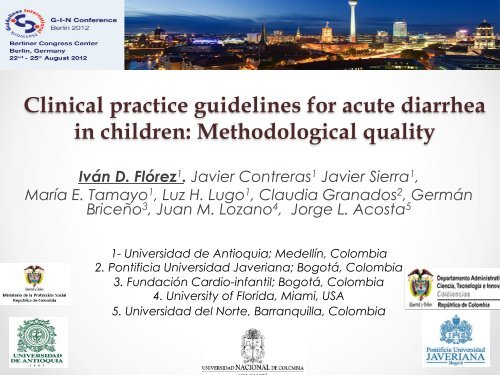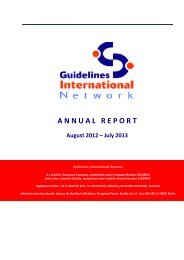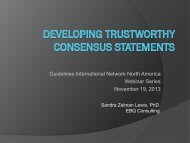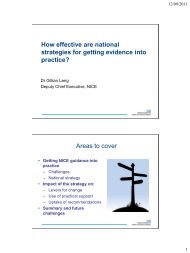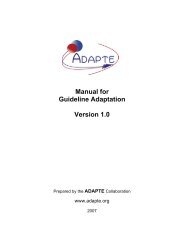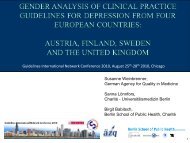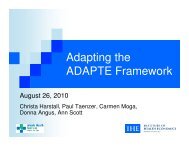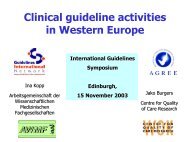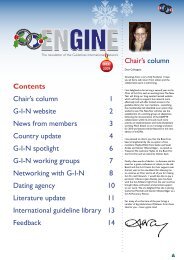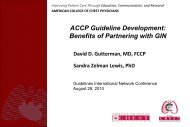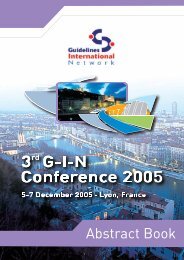Clinical practice guidelines for acute diarrhea in children ...
Clinical practice guidelines for acute diarrhea in children ...
Clinical practice guidelines for acute diarrhea in children ...
Create successful ePaper yourself
Turn your PDF publications into a flip-book with our unique Google optimized e-Paper software.
<strong>Cl<strong>in</strong>ical</strong> <strong>practice</strong> <strong>guidel<strong>in</strong>es</strong> <strong>for</strong> <strong>acute</strong> <strong>diarrhea</strong><br />
<strong>in</strong> <strong>children</strong>: Methodological quality<br />
Iván D. Flórez 1 . Javier Contreras 1 Javier Sierra 1 ,<br />
María E. Tamayo 1 , Luz H. Lugo 1 , Claudia Granados 2 , Germán<br />
Briceño 3 , Juan M. Lozano 4 , Jorge L. Acosta 5<br />
1- Universidad de Antioquia; Medellín, Colombia<br />
2. Pontificia Universidad Javeriana; Bogotá, Colombia<br />
3. Fundación Cardio-<strong>in</strong>fantil; Bogotá, Colombia<br />
4. University of Florida, Miami, USA<br />
5. Universidad del Norte, Barranquilla, Colombia
Background<br />
• Acute <strong>diarrhea</strong> (AD) is the second most common disease <strong>in</strong><br />
<strong>children</strong><br />
• AD is globally associated with high morbidity <strong>in</strong> developed<br />
countries and with high mortality <strong>in</strong> undeveloped countries.<br />
• The Colombian M<strong>in</strong>istry of Health f<strong>in</strong>anced the development<br />
CPG of some diseases <strong>in</strong> order to improve health care system<br />
and to do cost-effectiveness analysis. Diarrhea <strong>in</strong> <strong>children</strong> was<br />
one of them<br />
• We <strong>for</strong>med a guidel<strong>in</strong>e developer group (GDG) <strong>in</strong> order to<br />
develop the <strong>Cl<strong>in</strong>ical</strong> Practice Guidel<strong>in</strong>es (CPG) of prevention,<br />
diagnosis and treatment of <strong>diarrhea</strong>l diseases <strong>in</strong> <strong>children</strong>
Background<br />
• Be<strong>for</strong>e develop<strong>in</strong>g a de novo-CPG it is<br />
recommended to assess published <strong>guidel<strong>in</strong>es</strong> <strong>in</strong><br />
order to consider adaptation of a high quality CPG<br />
• There were a lot of CPG of <strong>diarrhea</strong> and<br />
gastroenteritis <strong>in</strong> <strong>children</strong> available <strong>in</strong> the literature<br />
• The quality of published <strong>guidel<strong>in</strong>es</strong> on childhood<br />
<strong>diarrhea</strong> was assessed by Lo Veccio et al. <strong>in</strong> 2011,<br />
but it had some flaws
Evaluation of the Quality of Guidel<strong>in</strong>es <strong>for</strong> Acute<br />
Gastroenteritis <strong>in</strong> Children With the AGREE Instrument<br />
ABSTRACT<br />
Evaluation of the Quality of Guidel<strong>in</strong>es <strong>for</strong> A<br />
Andrea Lo Vecchio, Antonietta Giannattasio, y Christopher Duggan, z Gastroenteritis <strong>in</strong> Children With the AGREE Ins<br />
Salvatore De Masi,<br />
§ jj<br />
Maria Teresa Ortisi, Luciana Parola, and Alfredo Guar<strong>in</strong>o<br />
Problems:<br />
Conclusions: The overall quality of CPGs on <strong>acute</strong> gastroenteritis<br />
Aim: The aim of the study was to assess the quality of cl<strong>in</strong>ical <strong>practice</strong><br />
management <strong>in</strong> <strong>children</strong> is fair. Aims, target population, synthesis of<br />
<strong>guidel<strong>in</strong>es</strong> (CPGs) us<strong>in</strong>g the Appraisal of Guidel<strong>in</strong>es <strong>for</strong> Research and<br />
evidence, <strong>for</strong>mulation of recommendations, and clarity of presentation<br />
Evaluation (AGREE) <strong>in</strong>strument, a validated <strong>in</strong>ternational tool.<br />
are po<strong>in</strong>ts of strength. Weak issues are applicability, <strong>in</strong>clud<strong>in</strong>g identifica-<br />
Materials and Methods: CPGs were identified by search<strong>in</strong>g MEDLINE<br />
tion of organizational barriers and adherence parameters, and cost/efficacy<br />
(1966–January 2009) and Embase (1988–January 2009), CPG databases,<br />
analysis.<br />
and relevant Web sites of agencies and organizations that produce and/or<br />
endorse • First <strong>guidel<strong>in</strong>es</strong>. version Included <strong>in</strong> the of study were the CPGsAGREE <strong>in</strong> English § that Key Words: <strong>acute</strong> gastroenteritis, AGREE <strong>in</strong>strument, child, <strong>guidel<strong>in</strong>es</strong><br />
addressed the management of <strong>acute</strong> gastroenteritis <strong>in</strong> <strong>children</strong>. Retrieved<br />
CPGs were evaluated with the AGREE <strong>in</strong>strument <strong>for</strong> quality assessment Maria <strong>in</strong>strument jj<br />
Teresa (JPGN 2011;52: Ortisi, 183–189) Luciana Parola, and Alfredo Guar<strong>in</strong>o<br />
by 6 <strong>in</strong>dependent reviewers. AGREE consists of 6 doma<strong>in</strong>s <strong>for</strong> a total of<br />
23 • items. Search was limited to English Clanguage Results: N<strong>in</strong>e CPGs were identified. Four were evidence based (EB) and<br />
l<strong>in</strong>ical <strong>practice</strong> <strong>guidel<strong>in</strong>es</strong> CPG (CPGs) are systematically devel-<br />
2 of these <strong>in</strong>cluded tables of evidence. Eight CPGs (88%) scored
Objective<br />
• To assess the quality of CPG on <strong>acute</strong><br />
<strong>diarrhea</strong> or gastroenteritis <strong>in</strong> <strong>children</strong> us<strong>in</strong>g<br />
the AGREE-II <strong>in</strong>strument (Spanish version).
Methods<br />
• Systematic review of CPG<br />
• Databases:<br />
o Electronic databases: EMBASE, MEDLINE, LILACS<br />
o National clear<strong>in</strong>ghouses<br />
o Non-electronic sources: Hand-search<strong>in</strong>g:<br />
• Known CPG by authors, researchers, members of the<br />
group and cl<strong>in</strong>ical experts<br />
• Pediatrics, gastroenterology, familiar medic<strong>in</strong>e and<br />
nurs<strong>in</strong>g congresses and textbooks<br />
• We searched from June to August of 2011
Methods<br />
• We exclude <strong>guidel<strong>in</strong>es</strong> that:<br />
o Were not Evidence-based<br />
o Had a different scope<br />
o Exclusive adult population<br />
o Diarrhea <strong>in</strong> <strong>children</strong> with chronic diseases<br />
• Each EB-guidel<strong>in</strong>e was <strong>in</strong>dependently assessed us<strong>in</strong>g<br />
AGREE-II (Spanish version) by three (3) cl<strong>in</strong>ical<br />
epidemiologists<br />
• Appraisers (MSc <strong>in</strong> <strong>Cl<strong>in</strong>ical</strong> epidemiology)<br />
o Genera practicioner (1), Pediatrician (6)
Methods<br />
• The assesment was made based on the <strong>in</strong><strong>for</strong>mation<br />
presented <strong>in</strong> the published version of the CPG and<br />
on the web site of the organization, <strong>in</strong>stitution or<br />
journals<br />
• We acceded when possible to evidence tables and<br />
search strategies by contact<strong>in</strong>g authors and<br />
<strong>in</strong>stitution by mail.
Methods<br />
• Spanish-AGREE II <strong>in</strong>strument has 23 items grouped <strong>in</strong><br />
6 doma<strong>in</strong>s and 2 f<strong>in</strong>al items <strong>for</strong> the global evaluation.<br />
• The score is calculated with proportions <strong>for</strong> each<br />
doma<strong>in</strong><br />
• There is not a m<strong>in</strong>imum score to recommend a CPG<br />
• Rigor of development was chosen as the most<br />
important doma<strong>in</strong> based on Colombian <strong>guidel<strong>in</strong>es</strong><br />
methodology manual<br />
• 60% was the cut off po<strong>in</strong>t to consider a high quality<br />
guidel<strong>in</strong>e
Methods<br />
• The score of each doma<strong>in</strong> was calculated based <strong>in</strong><br />
the 3 appraisers evaluation<br />
• Differences between the scores <strong>in</strong> each items were<br />
analyzed by one of the appraisers.<br />
• When differences between appraisers were more<br />
than 4 po<strong>in</strong>ts, they were asked to revaluate their<br />
score, <strong>in</strong> order to get a consensus<br />
• We calculated medians and <strong>in</strong>terquartile ranges<br />
(IQR) of the scores <strong>in</strong> each doma<strong>in</strong>
APPRAISAL OF GUIDELINES<br />
fOR RESEARCH & EVALUATION II<br />
INSTRUMENT<br />
___________________________________________________________________________________<br />
INSTRUMENTO AGREE II<br />
The AGREE Next Steps Consortium<br />
May 2009<br />
INSTRUMENTO PARA LA EVALUACIÓN<br />
DE GUÍAS DE PRÁCTICA CLÍNICA
Results<br />
• We found 63 <strong>diarrhea</strong> <strong>guidel<strong>in</strong>es</strong><br />
• 17 of which (26.9%) were evidence-based.<br />
• The rest (46 CPG) were: protocols, narrative reviews, Non<br />
evidence –based <strong>guidel<strong>in</strong>es</strong>, experts consensus, <strong>guidel<strong>in</strong>es</strong> of<br />
associations and organizations (WHO), cost-effectiveness<br />
studies<br />
• 10 <strong>in</strong> English language: Canada, India, UK, USA, Europe,<br />
Australia<br />
• 7 <strong>in</strong> Spanish language: Colombia, México, Guatemala, Costa<br />
Rica, Spa<strong>in</strong><br />
• Peer-reviewed journals-databases (6), textbooks (2), guidel<strong>in</strong>e<br />
developer web-site (1), academic <strong>in</strong>stitutions or scientific<br />
association (4) or government organizations (4)
Results<br />
• Doma<strong>in</strong>s 1 (scope and purpose) and 4 (clarity of<br />
presentation) had the highest scores: 74 (60-94%)<br />
and 78 (56,5-91%), respectively<br />
• Doma<strong>in</strong>s 5 (applicability) and 6 (editorial<br />
<strong>in</strong>dependence), had the lowest: 13 (2-24,5%) and 8<br />
(0-58%), respectively<br />
• Only five <strong>guidel<strong>in</strong>es</strong> scored over 60% <strong>in</strong> the third<br />
doma<strong>in</strong> (rigour of development) and were<br />
considered as “recommended”.
Results<br />
Recommended (5) Not recommended (12)<br />
• Doma<strong>in</strong> 5 : 31 (6-69%)<br />
• Doma<strong>in</strong> 6: 54 (0-97%)<br />
• Doma<strong>in</strong> 1: 93,5 (89-100%)<br />
• Doma<strong>in</strong> 4: 93,5 (89-95%)<br />
• Doma<strong>in</strong> 3: 70 (60-42%)<br />
• Doma<strong>in</strong> 2: 65 (42-95%)<br />
• Doma<strong>in</strong> 5 : 10 (0-15%)<br />
• Doma<strong>in</strong> 6: 8 (8-13%)<br />
• Doma<strong>in</strong> 1: 63 (17-79%)<br />
• Doma<strong>in</strong> 4: 69 (57-80%)<br />
• Doma<strong>in</strong> 3: 27 (20-40%)<br />
• Doma<strong>in</strong> 2: 26 (18-32%)
Discussion<br />
• There is an urgent need to improve the quality of<br />
CPGs <strong>in</strong> <strong>acute</strong> <strong>diarrhea</strong> <strong>in</strong> <strong>children</strong> by <strong>in</strong>corporat<strong>in</strong>g<br />
high quality standards <strong>in</strong> the development process<br />
based on the key po<strong>in</strong>ts of a high-quality CPG<br />
• Most of CPG were from developed countries<br />
• There are several <strong>diarrhea</strong> CPG available <strong>in</strong> Spanish<br />
language but its quality is quite low <strong>in</strong> comparison<br />
to English languages ones<br />
• Two CPG were retrieved <strong>for</strong>m Spanish textbooks
Discussion<br />
• There are a lot of CPG that are called EB-<strong>guidel<strong>in</strong>es</strong><br />
and they are not.<br />
• We retrieved CPG from databases, textbooks,<br />
developers websites, national clear<strong>in</strong>ghouses. The<br />
search of CPG must be much wider than that <strong>for</strong><br />
primary studies<br />
• Diarrhea is a common disease <strong>in</strong> <strong>children</strong>. It is<br />
desirable to have the best evidence-based<br />
recommendation available.
Discussion<br />
• First (1th) and 4th doma<strong>in</strong>s scored high (upper 60%) <strong>in</strong><br />
both recommended and not recommended CPG<br />
• Fifth and 6 th doma<strong>in</strong>s scored low <strong>in</strong> both recommended<br />
and not recommended CPG<br />
• Third doma<strong>in</strong> must be the one that makes the difference<br />
• Developers are concerned about describ<strong>in</strong>g Scope and<br />
objectives and about the clarity of presentation, <strong>in</strong>stead<br />
of be<strong>in</strong>g rigorous <strong>in</strong> methodology<br />
• We must be alert about the 3rd doma<strong>in</strong> better than<br />
others that seem “attractive”: Clarity of<br />
recommendations and scope
Limitations<br />
• We have conclusions that could not be reproducible<br />
<strong>in</strong> other diseases<br />
• We had a low number of CPG<br />
• The 60% as a cut-po<strong>in</strong>t was recommended by the<br />
Colombian <strong>guidel<strong>in</strong>es</strong>, and the group agreed with<br />
this score.<br />
• What about another cut-po<strong>in</strong>ts? 70 – 75 – 80 % ?<br />
• AGREE collaboration doesn’t recommend a score,<br />
so it could be controversial our cut-off po<strong>in</strong>t
Conclusions<br />
• There is low quality <strong>in</strong> Spanish language CPG on<br />
<strong>diarrhea</strong><br />
• Most of CPG on <strong>diarrhea</strong> were not evidence based<br />
• Most of evidence based CPG had low to moderate<br />
quality<br />
• In AGREE-II, Third doma<strong>in</strong> makes the difference<br />
• Scope and purpose, and clarity could be good<br />
even <strong>in</strong> low quality <strong>guidel<strong>in</strong>es</strong>
Danke!<br />
ivoflorez@gmail.com


